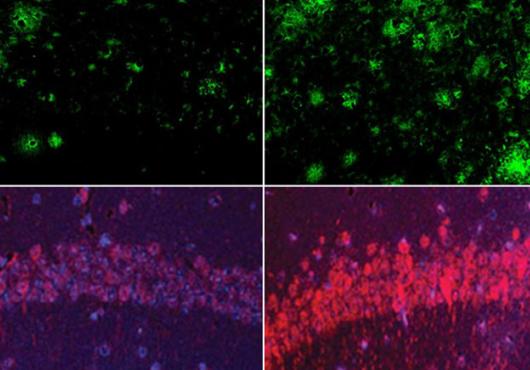The path that HIV follows to infect cells is well known. The glycoprotein on the outer shell of the virus, gp120, binds to CD4 receptors on T cells and, with the help of coreceptors, allows the virus to enter. Because it serves as a key that unlocks the doors of cells, gp120 has been studied thoroughly and emphasized in experimental vaccine development.
But now it seems that gp120 holds a second key into cells. Half of the molecule’s weight is from sugars, which a new study shows can also bind and gain entry into cells. A paper in the March 20 Proceedings of the National Academy of Sciences, led by J. Roberto Trujillo and Joseph Brain, details an unappreciated path of entry by HIV into macrophages. Yet this path, it turns out, is not infectious; instead, the virus is taken into the cell through phagocytosis. The discovery that HIV can get into cells without infecting them could be a promising guide for developing new vaccines.
Most attention on gp120 has focused on its interaction with protein receptors, through which it attacks its primary target, helper T cells. Still, research has suggested that HIV’s sugars are also important in disease. The viral envelope is studded with mannose sugars, which can attach at many different locations. “It’s unusual to have a virus with so much sugar on it,” explained Max Essex, a study co-author and the Mary Woodard Lasker professor of health sciences at HSPH. Essex noted that among HIV’s family of viruses, including the SIV virus that infects monkeys, those with the most sugar are also the most lethal. But why a sweeter virus is deadlier is unknown.
Brain, the Cecil K. and Philip Drinker professor of environmental physiology at HSPH, and Trujillo, formerly an HSPH investigator and now head of the Laboratory of Neurovirology in the Institute of Human Virology at the University of Maryland, began looking at carbohydrate interactions while studying infection by the fungus Pneumocystis carinii, which is the leading cause of death in people with AIDS. Though most people are exposed to this pathogen, it causes disease only in those with compromised immunity. Like HIV, P. carinii has a glycoprotein called gp120, and its carbohydrate portion attaches to the mannose receptor on macrophages. Normally, this receptor binds carbohydrates from a variety of pathogens, allowing the macrophage to ingest and swallow them. The researchers wondered if HIV’s gp120 might attach to the mannose receptor in the same way.
Using cells from mice and humans, the team found that, indeed, HIV’s gp120 can bind to the mannose receptor as its fungal counterpart does. Viral gp120 can block the ability of macrophages to ingest pathogens presenting sugars by occupying the mannose receptor.
In the brain, macrophages called microglia are an important first line of defense against pathogens. They also carry protein receptors for HIV and play a role in HIV infection in the brain and dementia. The team found that human microglial cells also carry the mannose receptor and that gp120 can bind to them through that receptor as well. The ability of circulating gp120 to “tie up” the mannose receptors on cellular defenders like these might be one reason why other infections are more likely to take hold in people with AIDS.
Once he and his colleagues had discovered this pathway, Trujillo spent a long time trying to figure out what was happening to the cells. It appears that when HIV uses the mannose receptor, it does not infect and incorporate its DNA into the host cell, but rather stays in the cytosol in a process that looks more like phagocytosis. Trujillo, who studies HIV infection in the brain, said it raises questions about microglia seen in the brains of AIDS patients that stain positive for HIV. “We have a cell in the brain that has both doors, the sugar door and the protein door,” he said. To what extent is HIV infecting cells and to what extent is it being sequestered or even being destroyed?
It is still not clear what role the mannose receptor pathway plays in HIV infection in vivo. But the discovery that immune cells have a doorway for HIV that does not lead to infection is promising. “It could be useful in designing a better vaccine,” Brain said. If it turns out macrophages that swallow HIV present the antigens to T cells, then a vaccine that exploits the sugar-based path into cells could provoke a more effective immune response against HIV in the absence of infection. The next step is to determine “whether this pathway can actually be utilized to produce an effective immune response and whether that would be protective,” he said.
Trujillo noted that from the standpoint of designing an HIV vaccine, carbohydrates have some distinct advantages. The protein portion of gp120 is notoriously changeable, which hinders the ability to design vaccines based on it. In contrast, he said, “many places where sugars are located in gp120 are in conserved regions. It always has the same sugar in exactly the same site.” A carbohydrate-based vaccine could potentially be effective against diverse strains of HIV.
The study also opens up new questions about the role of carbohydrates and their receptors in infection and disease. Brain said that proteins have captured most of the attention of the past decades because they are the products of genes and are seen as the major workhorses of the cell. Other components, like carbohydrates and lipids, have been seen as less important players. “There’s now more and more of a realization,” Brain said, “that carbohydrate chemistry can be critical.”


